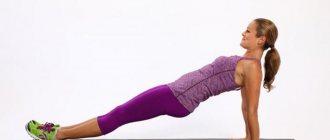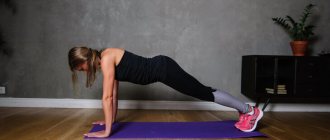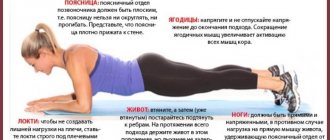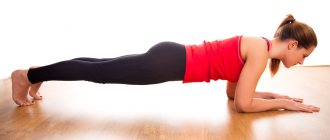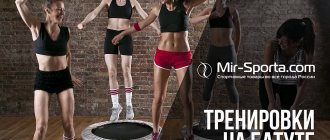The plank is one of the most effective and famous exercises for abs and a slim figure. In the sports community, it is considered a mandatory part of training, both during competitive preparation and to maintain shape.
We suggest you figure out how the plank exercise works, how to do it correctly without leaving home and gain a beautiful harmonious figure.
- Quick navigation through the article:
- The effectiveness of the plank exercise
- The benefits and possible harms of exercise
- What muscles are involved in the exercise?
- How to do a plank correctly (photo diagram for a month)
- Exercise frequency and schedule for 30 days
- How to do a side plank
- Body correction with a plank
- Who should not do the plank?
- Reviews
Benefits and possible harms of plank exercises for 30 days
Having received advice from a sports trainer about the principles of this training, we learned that the plank is an exercise whose main benefit lies in the load on the spine. Possible harm to human health can only occur in case of improper execution or individual contraindications.
In most cases, this exercise is a good prevention for the development of back and joint problems. If you have pain in the back, then using this method you can significantly improve the condition of the muscles of the vertebral part of the body.
Statistical load has a beneficial effect on the cardiovascular system. The plank stance puts stress on even the deepest muscles, which allows you to tighten your body without much effort and make it more flexible.
If we compare the positive and negative aspects of training, then there are certainly more of the former. By performing the exercise correctly, after 2-3 weeks you can be convinced of the improvement of the body.
If you regularly practice keeping your back straight, it will become a habit. As a result, you are guaranteed a straight and beautiful posture.
Reverse plank
As the name suggests, this plank is performed in exactly the same way as the classic straight plank, but from a position lying on your back or sitting on the floor. It is especially effective for people with various diseases of the back and spine muscles.
The support is either on the elbows and heels, or on the palms and heels. It is important to ensure that the body is completely straight; you cannot throw your head back or press your chin to your chest.
If you suddenly feel that you can no longer keep your hips in a straight line with a tense press, and your buttocks begin to sink down, it is better to stop doing the plank and take a break.
What muscles work in the plank exercise?
The plank involves almost the entire body. This is an excellent choice for strengthening the abs, buttocks, deltoids, serratus muscles, neck and many others. The maximum load falls on the core muscles. It is this muscle group that plays the role of stabilizer of the spine, pelvis and hips.
A short list of active muscles:
- rectus abdominis muscle;
- oblique abdominal muscle;
- transverse muscle;
- gluteus maximus muscle;
- rectus and traction muscles of the thighs.
For those who want to have a beautiful thin waist, it should be noted that it is the abdominal muscles that are responsible for the relief and twisting of the body. It is with them that almost all movements begin, so their role cannot be overestimated.
The tone of the core muscles maintains posture and protects the back from possible injuries . In addition to aesthetic beauty, pumped muscles allow you to increase all strength indicators. As you gain experience, you will be able to extend your class time.
As one of the most useful exercises for strengthening the spine, the plank is one of the least dangerous types of strength techniques for strengthening the spine.
Photos of people before and after regular exercise show the impressive effect of changes in slimness and stature in both men and women.
How to do the plank correctly and photo diagram for the month
Several methods of implementation are practiced, however, it is advisable to start with a classic base. Since the exercise is performed statically, it is important to take the correct position and try to keep it unchanged throughout the entire approach.
- Lie on your stomach and place your arms at right angles or rest on your elbows. This will reduce the stress on your joints.
- Keep your legs straight , resting only on your toes. Keep your feet together.
- The body should form a straight line without bending in the lumbar and pelvic areas. In the correct position, the buttocks will be tense. This activates the core muscles.
- Pull in and tighten your stomach . Keep it in this position until the end of the approach time.
It is important to keep your entire body tense to properly distribute the load and make your workout productive.
To increase the intensity, you can change the position of your arms or alternate leg raises. Such actions will make training in the plank pose more effective. Exercise, how to do basic approaches correctly, how long the training takes - this is only a small part of the useful information. Next, let's look at the standard execution scheme.
The program for beginners involves a stand of 30 seconds. To begin with, try to complete the basic exercise in a minimum amount of time. In the future, increase it to 2 minutes. If you do 3-4 approaches, then 1 minute is enough.
Execution technique
Let's move on to the technique of performing the plank exercise, the main points to pay attention to, and the main mistakes that beginners make.
- So, the starting position is lying on your stomach, facing the floor, feet shoulder-width apart;
- Bend your elbows so that they are in the same plane as your shoulders and form an angle of approximately 90 degrees;
- Raises the pelvis, tighten your buttocks, while keeping your legs and lower back straight. The body from heels to head should form one straight line.
A little advice: it is best to perform this exercise in closed shoes. This way you will reduce the pressure on your toes and will be able to spend a longer time in the effective (useful) phase of the exercise.
Start performing this exercise in several approaches lasting 30-45 seconds. Once you feel stronger, you can gradually increase the duration of the exercise. There are no restrictions on the duration of its implementation. You can regulate the duration yourself, however, this does not mean that you need to feel sorry for yourself! Having toned your muscles, you should perform this exercise for at least 2 minutes.
Main mistakes when performing the exercise:
- Holding your breath. Don’t do this, breathe evenly and calmly.
- Bend in the lower back. This is the most common mistake made by beginners. Be sure to control your lower back and always keep it straight.
- Knees touch the floor. As mentioned earlier, there is a straight line from the heels to the head.
- The pelvis is strongly raised above the level of the head. You should not increase the time of performing the exercise by violating the technique. Do less, but do it better.
- Head lift. By bending the cervical spine, you overload the muscles, which can cause problems later.
- Raise your elbows to the sides and lower your head to the floor. By making this mistake, you are not violating the work of the shoulder joints, which should be involved.
- Raising the shoulder blades up relative to the head. Don't make this mistake, and remember that the body should be straightened out.
Avoid these mistakes when performing the “Plank” exercise, and it will only give you a positive effect!
Exercise frequency and schedule for 30 days
The abdominal muscles love static load. Since they are almost constantly involved in work, they are quite easy to train. In the case of strength training, it is recommended to limit training time. But the plank is an exercise for 30 days of the month.
Even a few minutes in the position will significantly strengthen your torso muscles. Aim to do the exercise for at least 5 minutes a day. This time is enough to transform. The main thing is to follow the correct technique.
It is clearly visible that every day the approach time increases noticeably. The main thing is to follow the method and not give up. After 2-3 weeks, the plank exercise will be much easier for you. A photo diagram for the month will help you navigate and take breaks correctly during classes.
How to do the “Reverse Plank” exercise correctly
The position in question can be performed in various modifications. It can be both simplified and complicated. First of all, you need to take care of your comfort during the exercise so as not to get injured or slip. To do this, you need to lay a special rug or mat. Despite the fact that the likelihood of getting a fracture when falling from such a height is small, no one is immune from abrasions and hematomas. Therefore, it is necessary to perform the “Reverse Plank” carefully, concentrating only on it.
How to do a side plank
The side plank is considered a relatively difficult option. The exercise (before and after photos as an example) is most effective for correcting the sides. The fewer support points, the more the load on the abdominal muscles and inner thighs increases.
Take your starting position on your right side, resting on your elbow. Place your left hand on top of your thigh. Then tighten your abs and lift your body off the floor. This way you will support your weight on one hand. It is necessary to maintain balance by resting on your forearm and foot. The duration of the approach should be at least 10–15 seconds. Next, do reps on the other side.
The buttocks should be tense and fixed in position throughout the entire approach. Hips and feet must be kept together. This reduces the stress on your knee joints and increases the overall benefits of the exercise.
Timing your personal exercise
How often to do the plank - once a day or several approaches throughout the day, every other day or even once a week? How long should you hold it and how many approaches should you perform in one session? There is no single answer to these questions. To make an optimal recommendation, it is important to take into account factors such as age, weight, sports history or lack thereof, the presence of chronic diseases and sprains, the characteristics of joints and even hormonal levels in women.
The general rule is to very carefully send beginners into a static plank for half a minute, so that after this period of time they can assess whether it was easy to do, whether trembling appeared in the hands, whether the pressure rose, whether they were dizzy and what was happening with breathing and pulse. For a completely untrained person who has never lifted anything heavier than a fountain pen in his life, even such a load may initially be excessive. The former candidate for master of sports will easily stand this time and will not feel much tension in the muscles.
It’s worth finding your personal optimal time - with the help of a coach or on your own, using the selection method. The intensity - the type of plank and the number of approaches - and the duration of holding the plank at a time should be increased gradually. Periodically, you need to give your muscles complete rest so that they have time to completely relax and recover from microdamages.
On average, the increment in time for performing one type of plank is 10-15 seconds per week. The number of approaches should start with three and gradually increase to five to seven, but you should always focus on subjective sensations when performing any load.
Body correction with a plank
The practice of many women proves that using a plank can correct your figure and get rid of unwanted centimeters. There are proven effective methods on how to do the plank exercise correctly to lose weight.
The best way to make training useful for reducing volume is to alternate types of planks. By performing approaches with a minimum of rest breaks, you can achieve visible results in the shortest possible time. To lose belly fat, use the classic exercise with emphasis on your forearms. Try to hold on for at least 30 seconds.
For those wishing to reduce their waist, a side plank with torso tilts is a good option. When performing the workout on your side, you do not place your free hand on your hip, as described above. As you inhale, you need to raise your hand up, and as you exhale, smoothly turn your body and lower your hand. Then, while inhaling, take the starting position. The program consists of 10-12 repetitions on each side.
It is recommended to take short breaks and increase the load using light dumbbells.
For those who do not have the opportunity to go to the gym, the plank is the ideal solution. Just look at real examples of the results the plank exercise gives (photos before and after).
Women who methodically do this type of training experience the first results within 20–30 days. To achieve the goal you do not need to follow a special diet.
Classic version
Every beginner can do the classic exercise without any special training. It is done this way:
- Sit on a non-slip mat and extend your legs straight forward, bringing them together.
- Tilt your back 45 degrees, rest your hands on the floor so that your hands are clearly under your shoulders, and point your fingers towards your feet.
- Push your body up, distributing support on your arms and legs.
- Align your body in a straight line so that there are no bulges or bends.
- Hold the pose for 15 seconds, during which you should never relax your buttocks or abdomen.
- Smoothly lower yourself to the starting position, allowing yourself to relax only after your buttocks touch the floor surface.
It will not be difficult for experienced athletes to repeat a fixed pose immediately after the body has lowered itself onto the mat, because they have already mastered this exercise to the point of automatism. But beginners will need to take short breaks between approaches.
Who should not do the plank?
The plank is an almost harmless universal exercise. However, it has its limitations, like any physical activity. During pregnancy, you should not perform this exercise, as it can harm the baby. After giving birth, it is recommended to start training no earlier than a month later.
Absolute contraindications:
- chronic diseases during exacerbation;
- inflammation of internal organs;
- high blood pressure;
- spinal hernia;
- tunnel syndrome.
If you have a spinal injury, you should begin training with extreme caution or limit yourself to minimal load. Each case is individual, but it is better to consult a specialist. Listen to your body and seek help if necessary.
Physical training is a great way to get your body in good shape and make your figure beautiful. With minimal costs you are guaranteed to get maximum results.
